|
|
Mauricio Kagel (Composer) |
|
Born: December 24, 1931 - Buenos Aires, Argentina
Died: September 18, 2008 - Cologne, Germany |
|
Life |
|
The Argentine-born German composer, Mauricio [Maurizio] Kagel, was born from a Jewish family with both Russian and German origins. His family name Kagel (adopted by his grandfather), has German origins, and also a small town near Berlin is called so. He took private lessons of singing, orchestra conducting, piano, violoncello, organ, among also with Alberto Ginastera and Paz. His father gave him the first musical lessons but his first piano teacher was Vincenzo Scaramuzza, a pianist from Crotone, of whom, Mauricio Kagel, would keep a fervent souvenir for the rest of his life. At the university of Buenos Aires he studied with other teachers philosophy and literature, among them was also Jorge Luis Borges. He joined the Agrupacion Nueva Musica of Buenos Aires at the age of only 16 years old.
In 1950, Mauricio Kagel’s his first composition has been published, Palimpsestos, for an a-capella mixed choir and also Dos Piezas Para Orchestra. In 1950 he became the co-founder of the Cinémathèque Argentine. In 1954 he founded the Colon Theatre's orchestra in Buenos Aires. Collaborating with the periodical Nueva Vision he started getting interested in photography and cinema.
In 1957 Mauricio Kagel moved to Köln. He took interest in the study of electronic music, phonetics and science of communication at Meyer-Eppler in Bonn. From 1958 he was occupied in conducting orchestras. In 1960 he founded the Kölner Ensemble für Neue Musik. From 1960 until 1964 he taught as Professor at the Internationale Ferienkurse für Neue Musik in Darmstadt. From 1961 he directed many concerts, travelling through Europe and America. From 1964 he worked mainly in theatrical activities. Writing his own movies, he directed most of them, later produced by television.
In 1964-1965 Mauricio Kagel was nominated Slee-Professor for composition at the State University of New York in Buffalo. In 1967 he was professor, as guest of honour, at the academy for cinema and television in Berlin. In 1968 he was director of the “Skandinavische Kurse für Neue Musik” in Göteborg. In 1969 he was director of the Institut für Neue Musik at the Rhineland’s conservatory and from 1969 until 1975 he directed the Kölner Kurse für Neue Musik. From 1974 until 1979 he taught as Professor of the Neues Musiktheater alla Kölner Musikhochschule. He travelled lot, making many tours in Middle East and in Asia (1973) and South-America, USA, and Canada (1974).
Fantasy, humour and originality are the main peculiarities of his works, Mauricio Kagel became one of the most significant authors in Musical and Contemporary Theatre. During his artistical career, he directed himself most of his works, either as a producer than as a director of all his movies and radio programmes. He received a lot of honours and credits, he has been played in lots of important contemporary music festivals. One of his last appearance took place in July 2006, for his 75th birthday at the Colon Theatre of Buenos Aires, the Goethe-Institut and also the Margarita Xigu Theatre, being called as the symbol of cultural exchange between Germany and Argentina, with concerts and open rehearsals.
Invited by Walter Fink, Mauricio Kagel was the second composer featured in the annual Komponistenporträt of the Rheingau Musik Festival in 1991. In 2000 he received the Ernst von Siemens Music Prize. Among his students were Maria de Alvear, Carola Bauckholt, Branimir Krstić, David Sawer, Rickard Scheffer, Juan Maria Solare, Gerald Barry and Chao-Ming Tung. He died in Cologne on September 18, 2008 after a long illness, at the age of 76
A few weeks before he died, Mauricio Kagel gave his last interview, on the occasion of the festival Il nuovo - l'antico which took place in Bologna in October 2008. This interview sums up his idea of music and the philosophy which guided the Maestro during his long career as a composer, explaining by his own how he lived and felt the dearest thing for him: Music:
"... Each composer is convinced that his last masterpiece will be the most beautiful and important, but during my whole life, continuity has been always fundamental in my works. The different stages, can be qualified as organic; but contrary to many other authors, I was never subjected to any “shock” which would have caused a total change from one minute to the other in works. Such as when we talk about Picasso, we mention his blue, pink or cubist period etc… Such a thing has no sense for me, as my course has always been linear and I would even say organic. Of course some pieces are more or less important than others, but I’m not the right person to qualify them. The only thing I can declare, is that during my whole life, after I had finished a score, all my involvement, my soul and my love for music has been transferred in it. At the end, I have always been able to affirm: “that’s what I wanted, and so it had to be. Then the future will let us know…" |
|
Works |
|
Many of his later pieces give specific theatrical instructions to the performers (Kennedy & Bourne Kennedy 2006), such as to adopt certain facial expressions while playing, to make their stage entrances in a particular way, to physically interact with other performers and so on. His work comparable to the Theatre of the Absurd.
Staatstheater (1971) is probably the piece that most clearly shows his absurdist tendency. This work is described as a "ballet for non-dancers", though in many ways is more like an opera, and the devices it used as musical instruments include chamber pots and even enema equipment. As the work progresses, the piece itself, and opera and ballet in general, becomes its own subject matter. Similar is the radio play Ein Aufnahmezustand (1969) which is about the incidents surrounding the recording of a radio play.
Mauricio Kagel also made films, with one of the best known being Ludwig van (1970), a critical interrogation of the uses of L.v. Beethoven's music made during the bicentenary of that composer's birth. In it, a reproduction of L.v. Beethoven's studio is seen, as part of a fictive visit of the Beethoven House in Bonn. Everything in it is papered with sheet music of L.v. Beethoven's pieces. The soundtrack of the film is a piano playing the music as it appears in each shot. Because the music has been wrapped around curves and edges, it is somewhat distorted, but Beethovenian motifs can still be heard. In other parts, the film contains parodies of radio or TV broadcasts connected with the "Beethoven Year 1770". Kagel later turned the film into a piece of sheet music itself which could be performed in a concert without the film - the score consists of close-ups of various areas of the studio, which are to be interpreted by the performing pianist.
Other pieces include Con Voce (With Voice), where a masked trio silently mimes playing instruments and Match (1964), a tennis game for cellists with a percussionist as umpire (for Siegfried Palm), also the subject of one of Kagel's films and perhaps the best-known of his works of instrumental theatre.
Mauricio Kagel also wrote a large number of more conventional, "pure" pieces, including orchestral music, chamber music, and film scores. Many of these also make references to music of the past by, amongst others, L.v. Beethoven, Johannes Brahms, J.S. Bach, and Franz Liszt. He has been regarded by music historians as deploying a critical intelligence interrogating the position of music in society (Griffiths 1978, 188). |
|
Selected Works |
|
Stage works:
Staatstheater (1967/1970)
Mare nostrum, Scenic Play for countertenor, baritone, flute, oboe, guitar, harp, cello and percussion (1975)
Kantrimiusik, pastorale for voices and instruments (1975)
Vocal:
Fürst Igor – Strawinsky, a requiem for Igor Strawinsky for bass and instruments (1982)
Sankt-Bach-Passion for soloists, choirs and orchestra (premiered in 1985)
Mitternachtsstük for voices and instruments on four fragments from the diary of Robert Schumann (1980-1981/86)
Schwarzes Madrigal (Black madrigal), for choir, trumpet, tuba and 2 percussionists (1998/99)
In der Matratzengruft for tenor and ensemble (2008)
Orchestral:
Dos piezas for orchestra (1952)
Heterophonie' for orchestra (1959-1961)
Zehn Märsche, um den Sieg zu verfehlen (Ten marches in order to miss victory), for brass orchestra (1979)
Les idées fixes, rondo for orchestra (1988/1989)
Opus 1.991 for orchestra (1990)
Konzertstück (Concert piece), for timpani and orchestra (1990-1992)
Études for orchestra (I 1992, II 1995/1996, III 1996)
Fremde Töne & Widerhall (Strange sounds and echo), for orchestra (2005)
Chamber:
Transición II for piano, percussion, and two tapes (1958-1959)
Sonant for guitar, harp, contrabass, and skin instruments (1960)
Match for three players (1964)
String Quartet No. 1 (1965)
Piano Trio No. 1 (1985)
String Quartet No. 2 (1967)
Morceau de Concours for 1 or 2 trumpets (1968-1972)
Pan a tutti i Papagheni, for piccolo and string quartet (1985)
String Quartet No. 3 (1986)
String Quartet No. 4 (1993)
Schattenklänge, three pieces for bass clarinet (1995)
Art bruit for a percussionist and an assistant (1994/1995)
Piano trio No. 2, completed 11 September 2001
Phantasiestück for flute and piano
Experimental:
Acustica for experimental sound-producers and loud-speakers (1968-1970)
Dressur, trio for wood percussion (1977)
Rrrrrrr..., six duos for two percussionists (1982) |
|
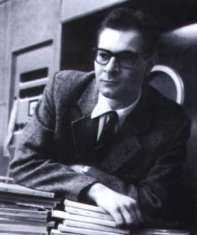
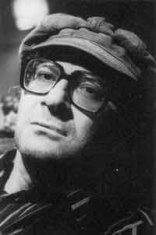
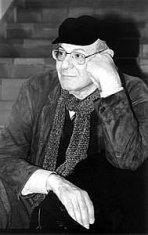

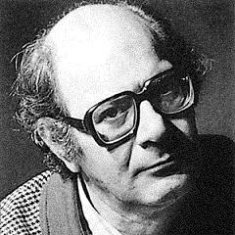
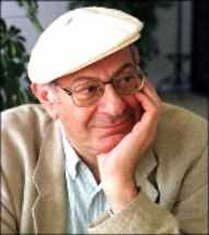
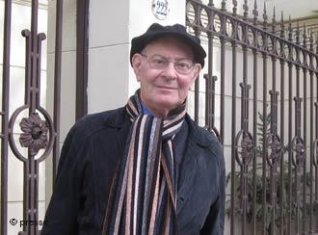
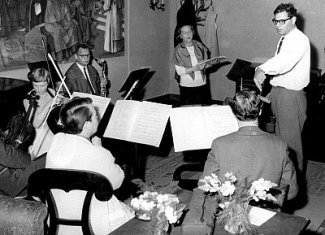
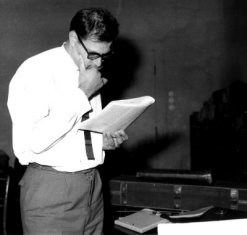
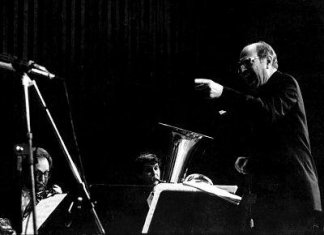
|
|
Sources:
Mauricio Kagel Website
Wikipedia Website (July 2012)
Contributed by Aryeh Oron (September 2012) |
|
Mauricio Kagel : Short Biography | Arrangements/Transcriptions: Works | Recordings of Vocal Works |
|
Links to other Sites |
|
Mauricio Kagel (Official Website)
Biografia de Mauricio Kagel, compositor argentino [Spanish/English]
Mauricio Kagel (Wikipedia) |
|
Bibliography |
| |
|
|